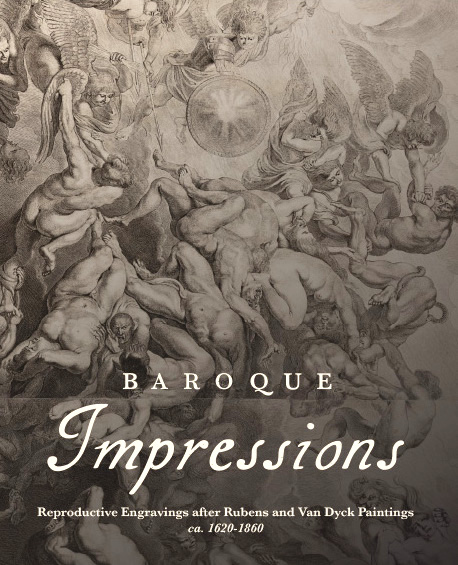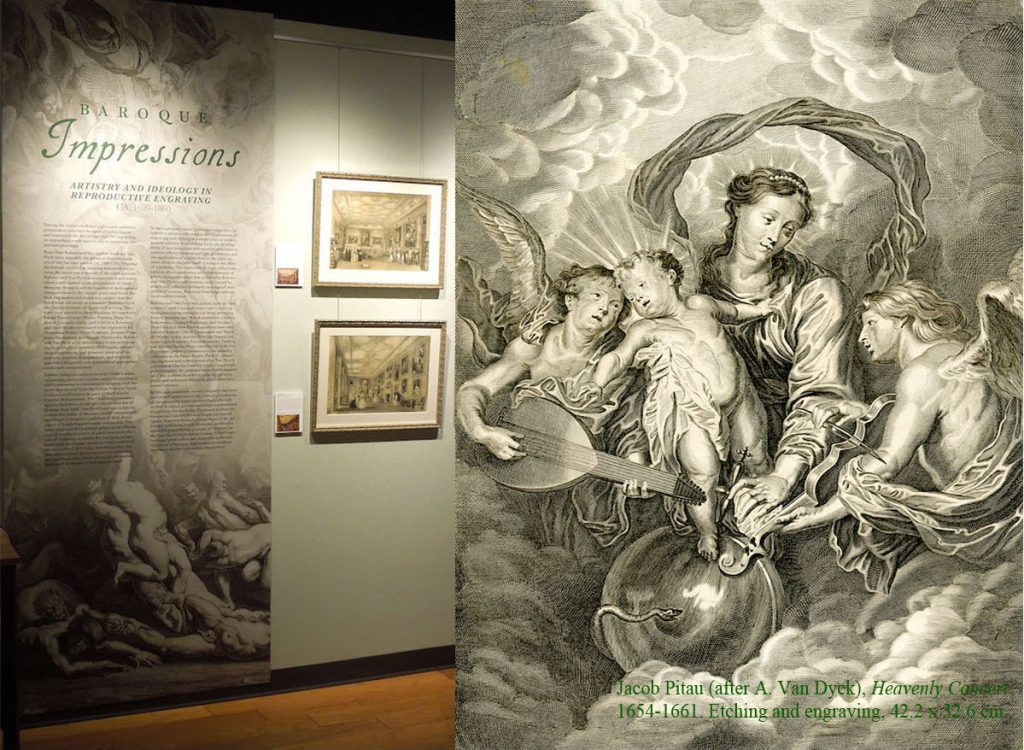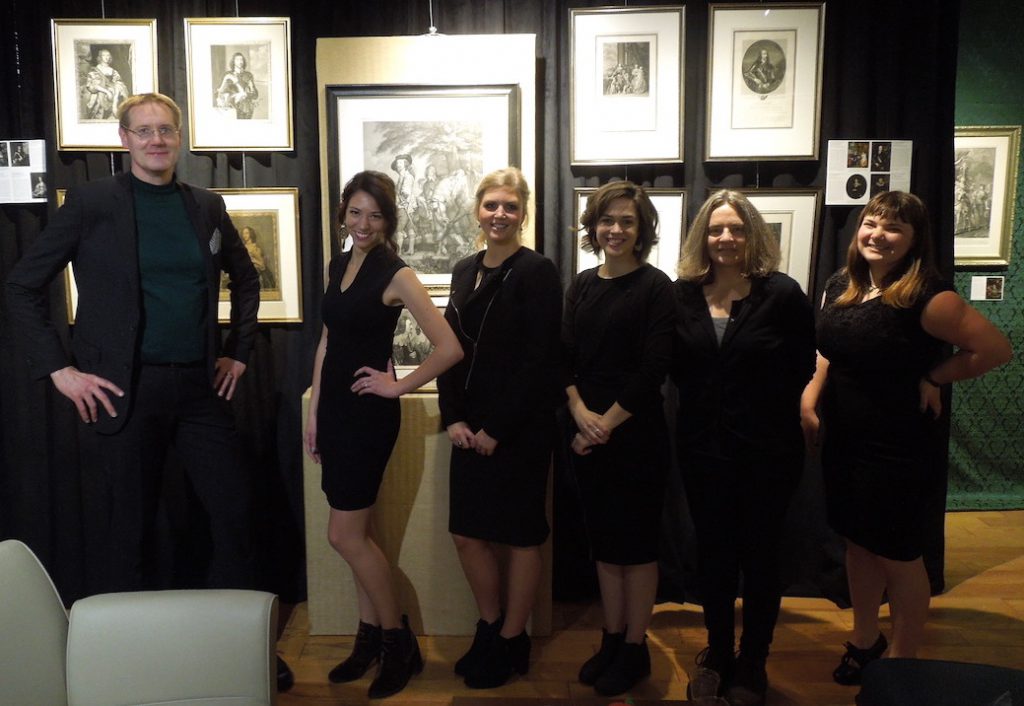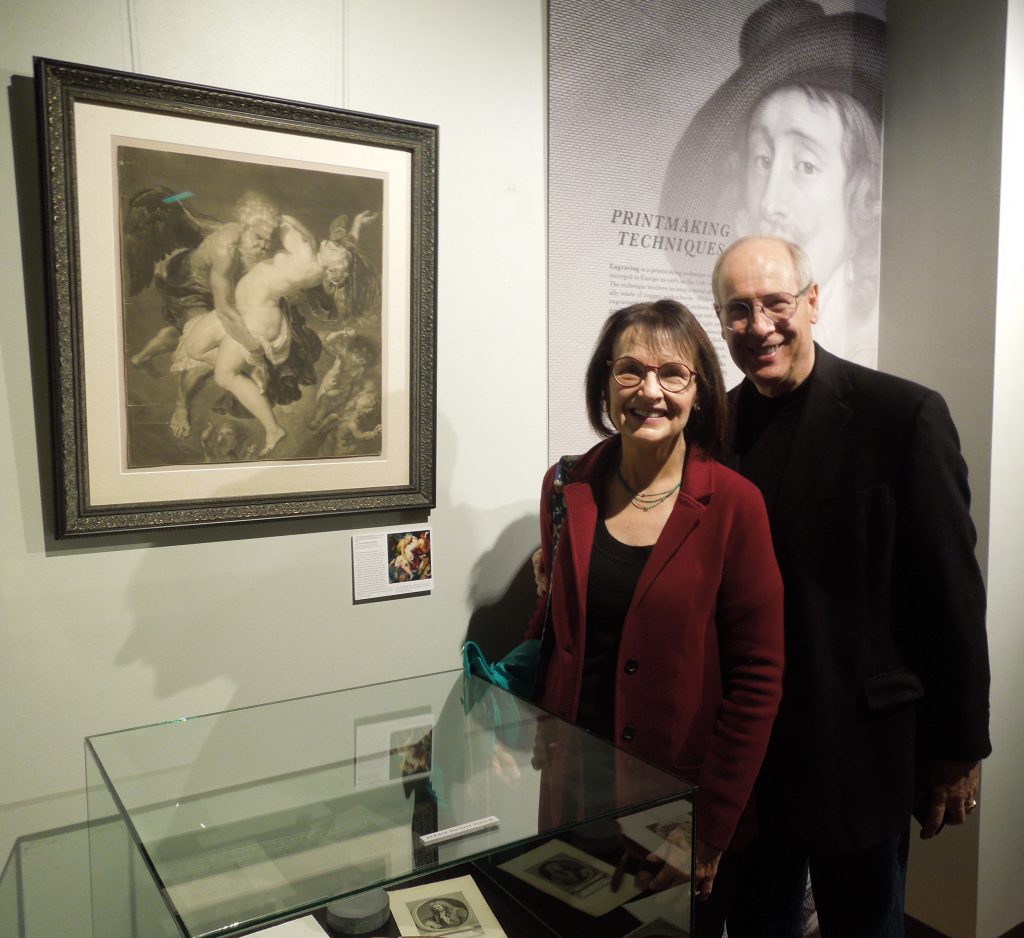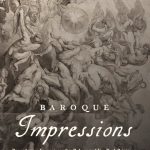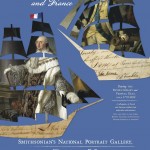On 25-26 September 2014, twenty-four curators and professors from North America and Western Europe converged on the National Portrait Gallery, Washington, D.C., to discuss their current research on the theme of Political Portraiture in the United States and France during the Revolutionary and Federal Eras ca. 1776-1814. Intended to mark the bicentennial of British destruction of the United States Congress’ portraits of Louis XVI and Marie-Antoinette, the event was organized by Dr. Todd Larkin and subsidized by the Terra Foundation for American Art, the Henry Luce Foundation, the Samuel H. Kress Foundation, and Montana State University.

Meta Newhouse, Advertisement for the Political Portraiture Conference, 2014.
Their premise was that the United States and France shared a political experience that had a distinct bearing on the way identity was configured in portraits. The transition from a monarchical to a republican form of government necessitated a shift from aristocrats to citizens as the primary patrons, subjects, and viewers of portraits. Artists attempted to work through a series of formal and conceptual problems which often resulted in subjects being rendered in ways that revealed an uneasy integration of old aristocratic forms and new republican values. As a complement to the forthcoming anthology of conference essays published by Smithsonian Institution Scholarly Press, this column serves as the first of a pair of reflections on portrait exchange between the two nations.
I. Dialect[ic]s of Diplomacy
Heads of state, ministers, and their emissaries in the United States and France challenged artists to represent an individual’s political authority, martial strength, or diplomatic reserve and deployed single-figure full- and half-length paintings, engravings, and miniatures abroad to support a “dialect[ic]s of diplomacy”—or strategic symbolic exchange—intended to strengthen ties between nations. Three forms of production and distribution contributed to a dialogue about shared interests: the gift of official portraits to foreign heads of state, the incorporation of distinguished foreigners into publicly viewed or circulated series, and the assimilation of foreign representational conventions into official portraits.
National governments, their emissaries or adherents sometimes gave portraits of heads of state, ministers and militia to foreign authorities for the sake of commemorating a treaty, celebrating a victory, or validating an alliance, thereby underlining a shared history of sacrifice and affirming a future commitment to coordinate policy.
In the United States, Congress alone could authorize expenditure on official portraits to be sent to foreign governments. The process worked something like this: the president, his minister, or a delegate sounded out the administration as to the cordial sentiments or strategic benefits of making such a gift and then prevailed on a member of Congress to introduce a motion, whereupon the matter would be referred to a committee and, pending chamber approval, would specify an established local artist and exact compensation. Because Congress was reluctant to spend tax revenues on portraits for dispatch to France in times of political and economic uncertainty, French officers and envoys often felt compelled to dig into their own pockets. For example, the marquis de Lafayette acquired a copy of the “Hancock” Washington (1776) showing the general standing nonchalantly, his hand tucked in his half-unbuttoned coat, perhaps in November 1776, some months prior to accepting the rank of major general and being wounded at the Battle of Brandywine, or in November 1777, a few weeks before defeating Hessian forces at Gloucester; returning to France in early 1779, Lafayette lobbied for troop reinforcements at Versailles and permitted artists to copy or otherwise disseminate the portrait in Paris. The ambassador Conrad Alexandre Gérard purchased a copy of George Washington after the Battle of Princeton from Charles Willson Peale in mid-July 1779, a few months before he was to embark on a return voyage to France. Peale had a British prototype in view—possibly Robert Strange’s mezzotint after Allan Ramsay’s George III (1761-62) or one of Gainsborough’s or Reynolds’ gentlemanly portraits—when he painted the commander-in-chief of Continental Forces in a buff-and-blue army uniform confidently leaning upon a canon following a decisive victory against the Hessians at the Battle of Princeton. Upon reaching Versailles, Gérard presented it to Louis XVI who received it as a sign of the allied commitment to loosen George III’s grip on North America. The comte de Rochambeau, a seasoned general invested with the command of French expeditionary forces, joined forces with Washington to achieve a decisive victory over Lord Cornwallis at Yorktown; he purchased a version of the “Princeton” Washington in mid-July 1782 and displayed it in the ancestral château at Thoré-la-Rochette in the central Loire, a reminder of the masterful coordination of regiments that forced the surrender of British troops.
In France, Louis XVI and Napoleon I and their intermediaries, the foreign minister and diplomatic corps, were by far the most liberal and sophisticated dispensers of gifts to American heads of state and ministers plenipotentiary involved in negotiating treaties of alliance and/or commerce. Generally, the minister of foreign affairs prevailed upon the minister/quartermaster of the Maison du roi (or royal/imperial household) or his subordinate the Surintendant des Bâtiments (superintendent of entertainments and gifts) for the production of an acceptable portrait model that could be duplicated in a central atelier to promote French power. The royal artist’s chief challenge was to conceptualize national sovereignty in terms of “absolute powers” and “dynastic succession.” Two portrait types were established. Louis XVI’s superintendent the comte d’Angiviller prevailed first upon Joseph-Siffred Duplessis and then Antoine-François Callet to develop acceptable bust and full-lengths of the king in court and ceremonial attire, an undertaking that gratified the progressive inclinations of a modern and highly literate audience and acknowledged the traditional message of Bourbon dynasticism. The foreign minister, the comte de Vergennes adopted Duplessis’ genial bust for miniatures and Callet’s dour full-length for canvases, although he did not always consider whether the imagery was appropriate for its recipient. Vergennes presented Silas Deane and Arthur Lee with gold and enamel tabatières (or snuffboxes) studded with diamonds and affixed with Pasquier’s hazy bust rendering to commemorate the signing of the Treaty of Amity and Commerce on 6 February 1778. He dispatched full-length canvases of the king and queen to Congress to commemorate their acceptance of the Treaty of Paris, which ended hostilities between the United States and Britain on 3 September 1783. Vergennes and his successor, the comte de Montmorin, offered diamond-incrusted boëtes à portrait (or portrait pendants) painted by Sicardi (a fusion of Callet’s head and an older ermine bib) to Franklin and Thomas Jefferson to mark the end of their terms as ambassador in 1785 and 1789, respectively. Finally, Montmorin approved six framed and twelve loose leaf grand format engravings printed by Charles-Clément Bervic (after Callet) for his new ambassador Jean-Baptiste Ternant to dispense to George Washington, Jefferson, Alexander Hamilton and others as a mark of royal favor upon his arrival in Philadelphia in late July 1791.
Private artist-innovators in major cities exhibited or published portrait series featuring revolutionary worthies, whether military commanders, government officials, assembly delegates, or foreign agents. The incorporation of distinguished foreigners promoted the notion of a comprehensive record, just cause, or shared values.
The largest single collection of portraits featuring “great men of the republic” could be seen in post-war Philadelphia. Conscious of its standing as the most populous city in the nation, several attempts were made to found an art society that would bring together local and visiting artists with an aim to sharing information about the latest trends and thus raise the caliber of American output, and compared to which the academies of Paris and London must have seemed like distant goals. From its opening in 1784 to its removal to more spacious quarters a decade later, Peale’s gallery at Third and Lombard Streets displayed an ever-growing register of oval bust portraits set in rectangular frames. Nearly half of the more than eighty-five pictures survive at Independence National Historical Park, and they suggest that the painter intended to commemorate an equal number of American military and civilian leaders, those responsible for leading soldiers to victory at sea or in the field and those distinguished for administering the state or national government, who had collectively forged the new republic. Peale rendered his subjects’ physiognomies naturalistically at life-size (the artist would later disclaim obsessive precision), from near full-face to profile to evoke the nobility of their characters or the significance of their deeds; he likewise clothed them in attire appropriate to their military, legislative or diplomatic duties. Karie Diethorn, who has catalogued the collection, has characterized Peale’s intention as follows: visitors were to view the wondrously varied portraits in reference to a series of catalog biographies, and thereby to learn how to model personal morality, public spiritedness, and self-sacrifice. There was William Smallwood (1781-82) dressed in the standard army uniform of dark blue with buff facings, the shoulders enhanced with gold epaulettes incorporating two stars to mark him as major general following the battle of Camden, John Adams (early 1790s) garbed in plain green coat, waistcoat, and white cravat to distinguish him as Vice President of the U.S., and Arthur Lee (1785) in a fancy braided silken brown coat and embroidered blue waistcoat befitting a life-long diplomat to Europe and the Indian tribes. Peale also included busts of French and German participants in the war, including ambassador Ann-César de La Luzerne, officers Marie-Joseph de Lafayette, Jean-Baptiste de Rochambeau, and François Jean de Chastellux, engineers Louis Antoine de Cambray Digny and Louis Le Begue de Presle du Portail, troop trainers and inspectors—most of them indistinguishable from their American hosts due to uniforms of dark blue with buff facings, golden epaulettes, and medals. However, La Luzerne, de Rochambeau, and de Chastellux (all ca. 1782) are distinguished as members of the nobility by more courtly embellishments: the envoy’s splayed coat and waistcoat are covered with gold braid, the commander’s coat bears a large embroidered Order de Saint-Louis and closes on a pink sash, and the general’s covering is edged in a costly spiral or wave pattern. For Peale, these fashion refinements were an essential part of the Frenchman’s identity as representatives of the king.
The Paris print market thrived with the outbreak of the Revolution and the unfettering of the press. Portraits of contemporary political actors—members of the royal family, assembly, military, philosophical and literary circles—enjoyed popularity commensurate with their ascendancy and demise. While print distributors could be found in the heart of the city (for example, the arcades of the Palais Royale), several print makers established studios on the outskirts. In the initial phase of the uprising, François Bonneville had set up shop at 4 rue du Théâtre français, some blocks east of Saint Sulpice, and by the Terror he had relocated to 195 rue Saint Jacques, in the shadow of the Pantheon. His specialty was small- to mid-sized oval stipple engravings of court, civilian, and military personalities adapted from well-known paintings or engravings and inscribed with a name, rank or occupation, and selective biographical data. Although historians have faulted the dark, heavy-handed manner, they also acknowledge the prolific output—four volumes of 50 portraits each of key figures of the Revolution, Louis XVI and Marie-Antoinette, Rohan and Lamballe, Marat and Corday, Bonaparte and Desaix between 1796 and 1802—which suggests a desire to stay current, attract a broad audience, and maintain profits. The most famous group, Portraits des personnages célèbres de la Révolution (1796-97), includes images of Washington adapted from an engraving by B.-L. Prevost (after a drawing by du Simitier) of the general posed in stoic profile in wig and uniform and Franklin from an engraving by F. Janinet or Chevillet (after a painting by Duplessis) of the diplomat with natural locks and fir-edged coat candidly reciprocating the viewer’s gaze. Appended texts make clear that while the one is honored as the former commander in chief and current President (of the United States, not Congress), the other is memorialized as a plainspoken friend (to France). Thomas Paine is represented in two prints (ca. 1791, 1793) of varying quality, the first a lifeless doll (after a much better painting by Peale), described as the author of Common Sense and responses to Edmund Burke, and the second a perceptive politician (after a painting by George Romney), with head turned three quarters to the right emerging from deep chiaroscuro, perhaps to suggest an evil portent in the wake of his recent dismissal from the National Convention. These men of virtue, action, and intellect constituted the new political order.
Finally, the most successful artists assimilated foreign portrait conventions in order to achieve an illusion of stately splendor or lifelike naturalism for diplomats desirous of currying favor with a foreign ally or for legislators bent on securing a place in the nation’s history.
Gilbert Stuart’s education was in many ways typical of artists who left America in search of training and patronage, having entered Benjamin West’s London studio in 1775 and having distinguished himself in full-figure portraiture at Royal Academy exhibitions of the 1780s. Returning to the United States in 1793, he settled in a small town in reach of Philadelphia and entertained George Washington to two sittings before achieving an indelible likeness—the so-called Athenaeum portrait (1796), an unfinished droopy-eyed, heavy-jowled presidential half-length meant to serve as the companion to an image of Martha Washington. Retaining it as a reference, Stuart would go on to elaborate it in full- and half-length portraits wherein the bulky frame was clad in black velvet that emphasized the sobriety of the office and accompanied by a ceremonial sword that signified an independence forged in blood. William Bingham commissioned one portrait for the Marquis of Lansdowne (1796) showing the president on his feet addressing an assembly and William Kerin Constable ordered another for Alexander Hamilton (1797) showing the president seated perusing a document. Dorinda Evans has emphasized the artist’s attention to French grand format engravings for the magnificent settings of both images: Pierre-Imbert Drevet’s Bishop Jacques-Bénigne Bossuet after Rigaud (1723) for the parapet supporting paired columns and drapery, carved table and chair in the Lansdowne portrait, and the same engraver’s Samuel Bernard (1729) for the nautical vignette in the Hamilton portrait. Rather than adopting Ramsay’s mode of depicting the sovereign in graceful contrapposto amid a table laden with regalia and a curtain looped to a column, Stuart embraced Rigaud’s approach to rendering the prelate and financier with a grave expression, loaded gestures, and workaday implements because it embellished the plain president and asserted his authority with the European monarchies. The reworking nearly made its way to France: Charles Cotesworth Pinckney ordered a copy of Stuart’s “Lansdowne” George Washington prior to embarking for Paris to preside over the American legation in September 1796; he specified that it should be sent to him as soon as it was ready, for he intended to present it to the French republic to ameliorate maritime tensions in light of America’s trade pact with the British monarchy; but the picture never reached its destination, possibly because Stuart, hearing that the Directory refused to receive the envoy, retained both portrait and fee.
Jean-Antoine Houdon was the product of the competitive training offered by the French state, having registered as a student of Michel-Ange Slodtz at the Académie royale de peinture et de sculpture in 1758 and having won a series of competitions (with religious subjects) that allowed him to advance to the École des élèves protégés and the Académie de France à Rome as a student pensioner in the 1760s. Returning to Paris in 1768, he was accepted as an agréé (a candidate for membership) in the academy and distinguished himself with a series of startlingly naturalistic bust portraits of theatrical and literary luminaries—Gluck, Molière, Voltaire, Rousseau—in the late 1770s. Houdon’s newfound celebrity, coupled with French participation in the American war, led to commissions to depict Louis XVI and Franklin. On 22 June 1784, the Virginia legislature voted to commission a marble statue of Washington, and at the end of the year Jefferson wrote Washington that Houdon was the best sculptor to be entrusted with accomplishing it, though Houdon would only undertake it in the expectation that Congress would also commission an equestrian image of Washington. All parties having agreed on the choice of Houdon, Governor Harrison of Virginia asked Peale to furnish the sculptor with a life-size portrait of Washington that could serve as a point of reference; completed in late October, Peale’s image arrived in Paris the following April. But Houdon refused to render an important personage in full scale without direct observation, and therefore departed with Franklin on the trans-Atlantic packet on 28 July 1785. Washington entertained Houdon at Mount Vernon for more than two weeks in October, submitting to a plaster mask, clay studies, and measurements. At work in Paris by the end of the year, the academician completed a marble bust à l’antique in time for the Salon of 1787 and the statue in military attire by the Salon of 1793. Installed in the rotunda of the capitol at Richmond in mid-May 1796, Houdon’s sculpture possessed a realistic head with deeply cut, visionary eyes resting on a confident, solid neck and an expansive body. The gentle sway, the coat with epaulettes, waistcoat, and breeches, and the splayed feet with left boot advancing slightly had all be adapted from Peale’s model. In conformity with the guidelines, the president has cast aside sword and canon for the more pedestrian implements of walking stick and plow, the only sign of his authority being the thirteen-rod fasces that serves as a resting post. It was as a man of peace and prosperity that he was to be remembered. Yet there is no record of a dedication ceremony, local sentiment having changed due to Washington’s support of John Jay’s commercial treaty with Britain, which Jefferson opposed out of loyalty to France.
Sources:
Arnason, H.H. “George Washington,” in William Howard Adams, ed., The Eye of Thomas Jefferson (Washington D.C.: National Gallery of Art, 1976), 108 (no. 172).
Barbier, Monique. “Abbreviated Chronology of Houdon’s Life and Career,” in Anne L. Poulet, Guilhem Scherf, Ulrike D. Mathies, Christoph Frank, Claude Vandalle, Dean Walker, and Monique Barbier, Jean-Antoine Houdon: Sculptor of the Enlightenment (Washington D.C.: National Gallery of Art, Chicago: University of Chicago Press, 2003), 348-349.
Barratt, Carrie Rebora and Ellen G. Miles. Gilbert Stuart (New York: Metropolitan Museum of Art, New Haven: Yale University Press, 2004), 147-153 (no. 39), 180-181 (no. 47), 274.
Belleudy Jules. J.-S. Duplessis, peintre du roi, 1725-1802 (Chartres: Imprimerie Durans, 1913), 57-74.
Bruel, François-Louis. Un siècle d’histoire de France par l’estampe 1770-1871: Collection de Vinck: Inventaire analytique, tome 1: ancien régime (Paris: Imprimerie Nationale, 1909), 541-542 (nos. 1159-1160).
Chabaud, Jean-Paul. Joseph-Siffred Duplessis 1725-1802 (Mazan: Etudes Comtadines, 2003), 50-59.
Chernow, Ron. Alexander Hamilton (New York: The Penguin Press, 2004), 335.
Diethorn, Karie. “’Good and faithful paintings’: Charles Willson Peale’s Philadelphia Museum Portraits,” in Doris Devine Fanelli and Karie Diethorn, eds., History of the Portrait Collection, Independence National Historical Park (Philadelphia: American Philosophical Society, 2001), 67-68.
Evans, Dorinda. The Genius of Gilbert Stuart (Princeton, NJ: Princeton University Press, 1999), 63, 67-70, 82-83.
Jean-Richard, Pierrette. Inventaire des miniatures sur ivoire conservées au cabinet des dessins Musée du Louvre et Musée d’Orsay (Paris: Réunion des musées nationaux, Paris, 1994), 316 (nos. 578, 579).
Jefferson, Thomas to Virginia delegation to Congress, n.d. (ca. 1784), in Ronald E. Heaton, The Image of Washington: The History of the Houdon Statue (Norristown, PA: Ronald E. Heaton, 1971), 8-9.
La Luzerne, Anne-Cesar de. Letter to Joseph-Matthias Gérard de Rayneval, 27 July 1783, Correspondance Politique, États-Unis, 25, Archives du Ministère des Affaires Étrangères, La Courneuve.
Larkin, T. Lawrence. “A ‘Gift’ Strategically Solicited and Magnanimously Conferred: The American Congress, The French Monarchy, and the State Portraits of Louis XVI and Marie-Antoinette,” Winterthur Portfolio, 44, 1 (Spring 2010): 63.
Lespinasse, Pierre. La Miniature en France au XVIIIe siècle (Paris: Éditions G. Van Oest, 1929), 158-159.
Miles, Ellen. “Gilbert Stuart’s Portraits of George Washington,” in George Washington: A National Treasure (Washington, D.C.: Smithsonian Institution, Seattle: University of Washington Press, 2002), 95.
Milley, John C. “Portraiture: Commemorative and Symbolic,” in Doris Devine Fanelli and Karie Diethorn, eds., History of the Portrait Collection, Independence National Historical Park (Philadelphia: American Philosophical Society, 2001), 7, 9.
Montmorin, Armand Marc de. Memorandum of 22 January 1791, Folder “1789-1793: Revolution,” Carton “Présents et pierreries 1783-1830,” 750SUP/220, Archives du ministère des affaires étrangères, La Courneuve.
Morgan, John Hill and Mantle Fielding. The Life Portraits of Washington and their Replicas (Philadelphia: Printed for the Subscribers, 1931), 94.
Portalis, Roger and Henri Béraldi. Les Graveurs du dix-huitième siècle (Paris: Damascène Morgand and Charles Fatout, 1880), 1:220-221.
Poulet, Anne L. “George Washington (1732-1799),” in Poulet, Guilhem Scherf, Ulrike D. Mathies, Christoph Frank, Claude Vandalle, Dean Walker, and Monique Barbier, Jean-Antoine Houdon: Sculptor of the Enlightenment (Washington D.C.: National Gallery of Art, Chicago: University of Chicago Press, 2003), 263 (no. 47), 265.
Reaves, Wendy Wick. “The Prints,” Magazine Antiques, 135, 2 (February 1989), 502-502.
Régistre journal des présens faits au nom du roi dans le Départment des affaires étrangères depuis 1753 jusqu’à 1791, 25 March 1778, 7 June 1785, 10 April 1791, MD 2095, Archives du Ministère des Affaires Étrangères, La Courneuve.
Sandoz, Marc. Antoine-François Callet (1741-1823) (Paris: Editart-Les Quatre Chemins, 1985), 96-101.
Sellers, Charles Coleman. Charles Willson Peale (New York: Charles Scribner’s Sons, 1969), 175-176, 201, 221, 223 (no. 898).
Sellers, Charles Coleman. Portraits and Miniatures by Charles Willson Peale (Philadelphia: American Philosophical Society, 1952), 228 (no. 905), 232 (no. 919).
Washington, George. Letter to Jean-Baptiste Ternant, 22 December 1791, in John C. Fitzpatrick, ed., Writings of George Washington (Washington D.C.: U.S. Government Printing Office, 1939), 31:44
Whitley, William T. Gilbert Stuart (Cambridge, MA: Harvard University Press, 1932), 114-115.
Wick, Wendy C. George Washington: An American Icon: The Eighteenth-Century Graphic Portraits (Washington, D.C.: Smithsonian Institution Traveling Exhibition Service and National Portrait Gallery, 1982), 28-30, 46-47.
